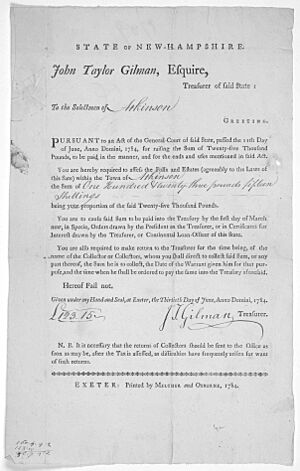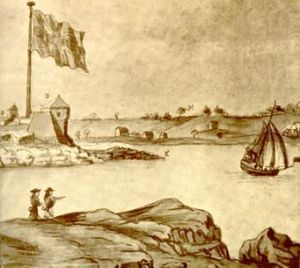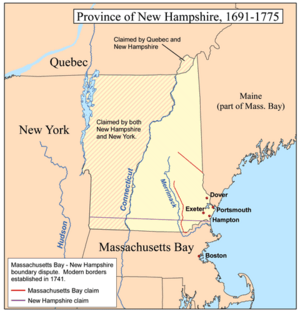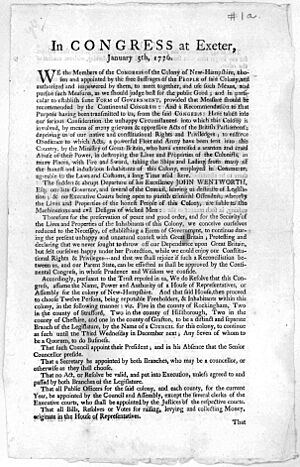History of New Hampshire facts for kids
New Hampshire is a state in the northeastern United States. It's part of the New England region. It was one of the original Thirteen Colonies that fought against British rule in the American Revolution. New Hampshire is one of the smallest states in both size and population. For a long time, it was known for making textiles (like cloth). Today, it's famous for its important presidential primary election, fun outdoor activities, and its role in the computer and biotech industries near Boston, Massachusetts.
Contents
New Hampshire's Early Days: 1600s to 1775
The land that became New Hampshire was first given as a grant in 1622. This grant was divided in 1629. Captain John Mason and Sir Ferdinando Gorges received parts of this land. Mason named his part "New Hampshire" after his home county in England.
The first Europeans settled in New Hampshire in 1623. A group of fishermen from England, led by David Thompson, settled at Odiorne's Point in Rye. This was just three years after the Pilgrims landed at Plymouth.
Other settlements followed. Edward and William Hilton led an expedition to the Dover area. Later, a new company formed in 1629. Their settlement was called Strawbery Banke, which is now Portsmouth. In 1638, John Wheelwright founded Exeter.
In 1631, Captain Thomas Wiggin became the first governor of the Upper Plantation. This area included modern-day Dover, Durham, and Stratham. All the towns agreed to unite in 1639. However, the larger colony of Massachusetts claimed the territory.
In 1641, New Hampshire agreed to be part of Massachusetts. The towns were still allowed to govern themselves. In 1653, Strawbery Banke changed its name to Portsmouth.
New Hampshire's relationship with Massachusetts was often difficult. The heirs of John Mason also kept claiming land. In 1679, King Charles II separated New Hampshire from Massachusetts. He created the royal Province of New Hampshire, with John Cutt as governor.
New Hampshire became part of the Dominion of New England in 1686. This group of colonies broke apart in 1689. After a short time without a formal government, a new charter was issued in 1691. From 1699 to 1741, the governors of Massachusetts also governed New Hampshire.
New Hampshire was on the edge of British and French lands in North America. It was also claimed by Native American groups. Because of this, New Hampshire was often involved in wars. These included King William's War, Queen Anne's War, and King George's War. By the 1740s, most Native Americans had left the province.
Because New Hampshire and Massachusetts shared a governor, their border issues were not fixed for many years. These problems were mostly about land west of the Merrimack River. In the 1730s, New Hampshire leaders pushed for these issues to be solved. In 1741, King George II ruled on the border. He decided that the border with Massachusetts would be much like it is today. He also separated the governorships. Benning Wentworth became New Hampshire's first non-Massachusetts governor in 1741.
Wentworth then made New Hampshire's land claims even more complicated. He believed the province included land west of the Connecticut River. He started giving out land grants in this area. However, the Province of New York also claimed this land. This disputed area became the state of Vermont in the 1790s.
New Hampshire and the American Revolution: 1775–1815
New Hampshire was one of the Thirteen Colonies that rebelled against British rule. In January 1776, it became the first colony to create its own independent government. It was also the first to write a constitution. However, this constitution said they did not want to fully break away from Great Britain. Rhode Island was the first to actually declare its independence.
An important attack on Fort William and Mary (now Fort Constitution) helped the American cause. The cannons and ammunition from the fort were used by the Continental Army. They were needed for the Battle of Bunker Hill near Boston a few months later.
New Hampshire sent three regiments to the Continental Army. These were the 1st, 2nd, and 3rd New Hampshire regiments. New Hampshire militia units also fought in many battles. These included the Battle of Bunker Hill, Battle of Bennington, and the Saratoga campaign.
Ships for the Continental Navy were built in Portsmouth, New Hampshire. These included John Paul Jones's ship, the USS Ranger, and the USS Raleigh. Other privateer ships were also built to hunt British merchant ships.
Concord was named the state capital in 1808.

Growth and Change: 1815–1860
In the 1830s, New Hampshire had an interesting news story. A small area on its northern border with Canada formed its own country. It was called the Republic of Indian Stream. This happened because of an unsolved border issue after the American Revolution.
In 1835, a special school called Noyes Academy was founded in Canaan, New Hampshire. It was started by people from Dartmouth College who were against slavery. This school was unique because it allowed both white and Black students to learn together. However, some local people did not like the idea of integrated education. Within months, they used oxen to drag the school away and then burned it down.
Many people in New Hampshire were against slavery. The Free Soil Party, led by John P. Hale, had strong support. However, the conservative Jacksonian Democrats usually held power. In 1856, the new Republican Party, led by Amos Tuck, brought a big political change.
New Hampshire in the Civil War: 1861–1865
When the American Civil War began, New Hampshire quickly supported the Union. The state sent 31,650 enlisted men and 836 officers to fight. Of these, many were killed or wounded.
New Hampshire provided eighteen volunteer infantry regiments. Thirteen of these were formed in 1861 after President Lincoln asked for volunteers. The state also sent three rifle regiments, one cavalry battalion, and two artillery units. Many New Hampshire men also joined the Navy and Marine Corps.
One of New Hampshire's most famous units was the 5th New Hampshire Volunteer Infantry. It was led by Colonel Edward Ephraim Cross. This regiment was known as the "Fighting Fifth" in newspapers. It was considered one of the best Union regiments during the war. Historians also agree it was an excellent fighting unit. This regiment had the highest number of battle-related deaths of any Union regiment.
Modern New Hampshire: 1950–Present
After World War II, New Hampshire became more connected to the greater Boston, Massachusetts area. This is a common trend where better highways help cities grow into nearby rural areas.
In 1952, the old Nashua textile mill was replaced by Sanders Associates, a defense electronics company. In the early 1970s, the computer company Digital Equipment Corporation arrived. These changes helped southern New Hampshire become a center for high-tech industries. It became an important part of the "Route 128 corridor" of tech companies in Massachusetts.
The years after the war also saw the rise of New Hampshire's political primary. This is the first primary election for President of the United States every four years. It gets a lot of attention from across the country.
Images for kids






